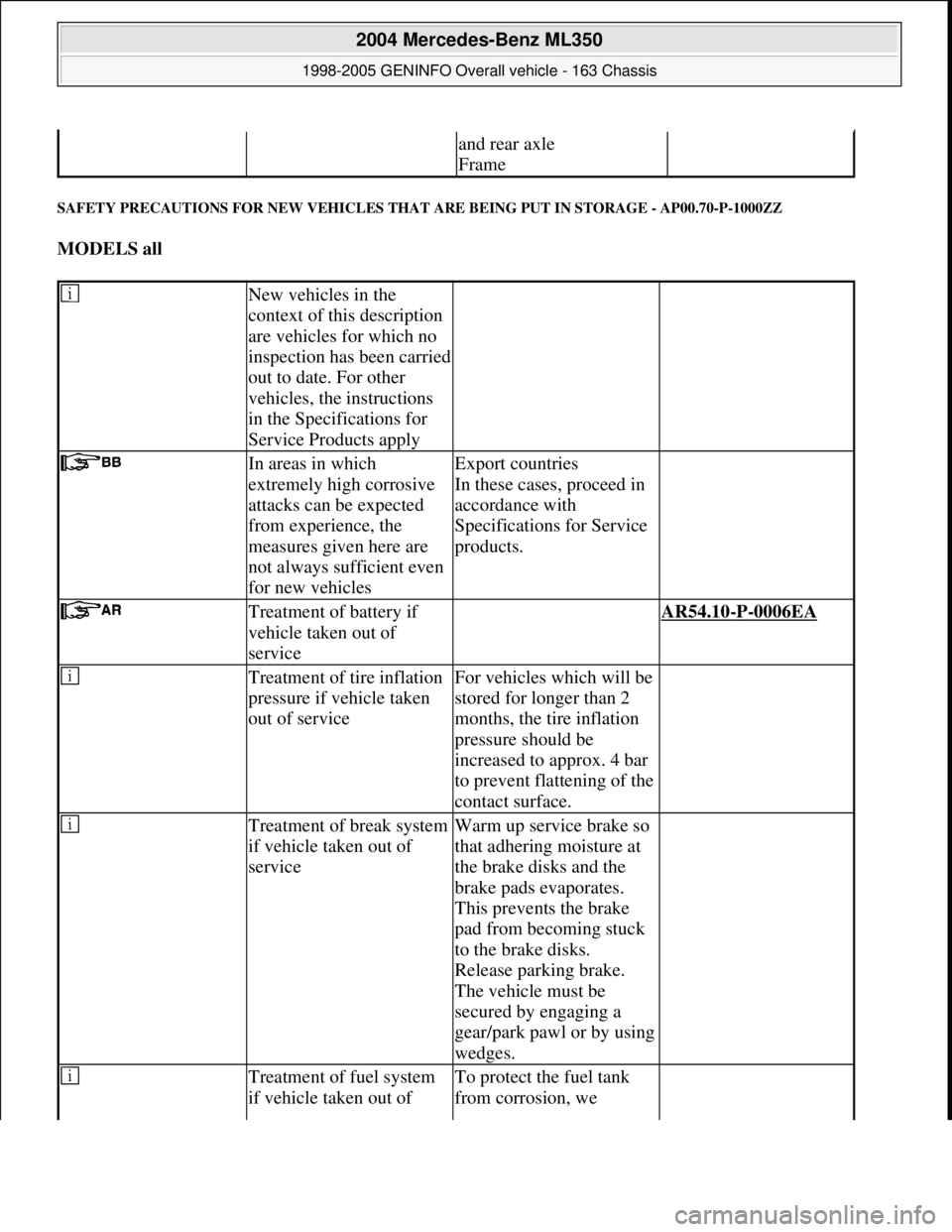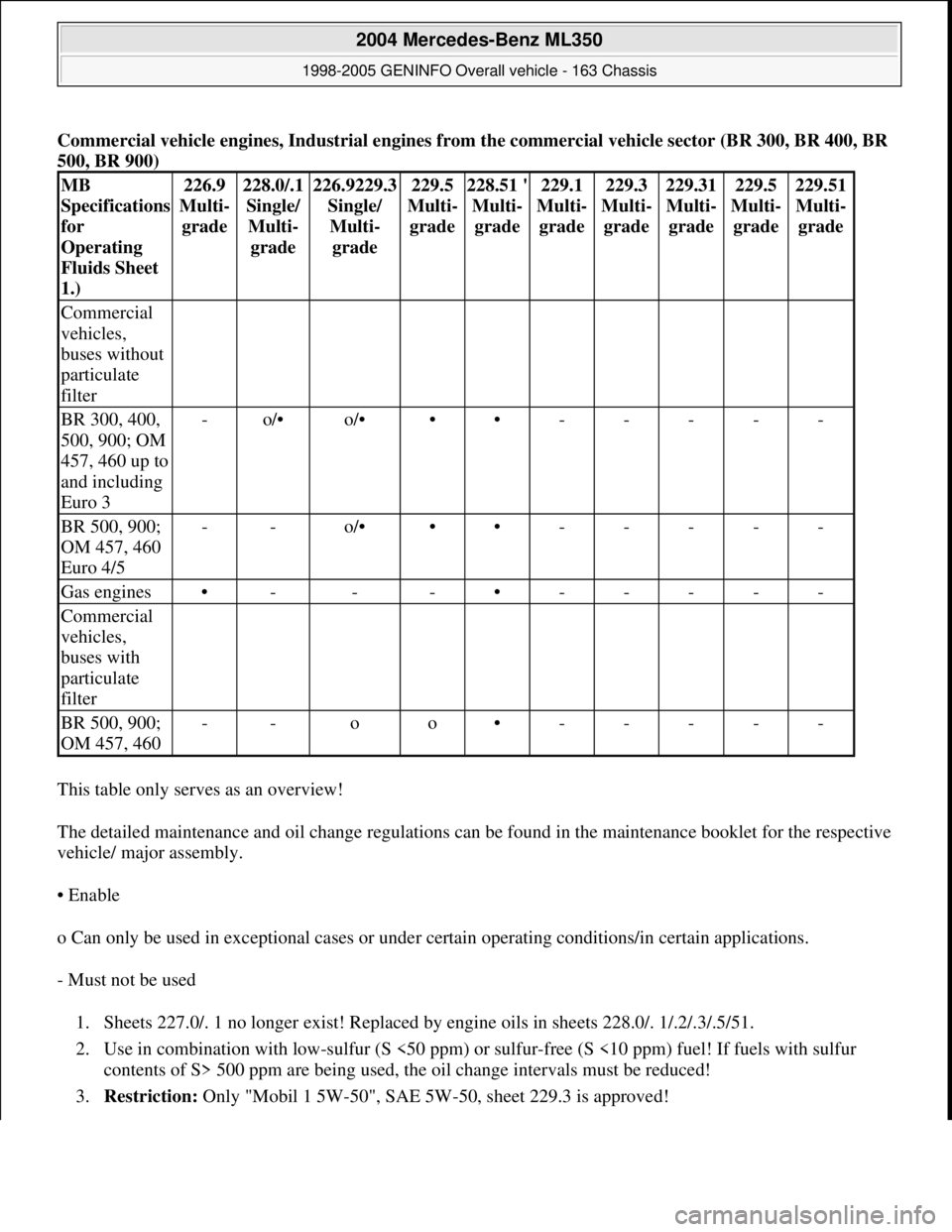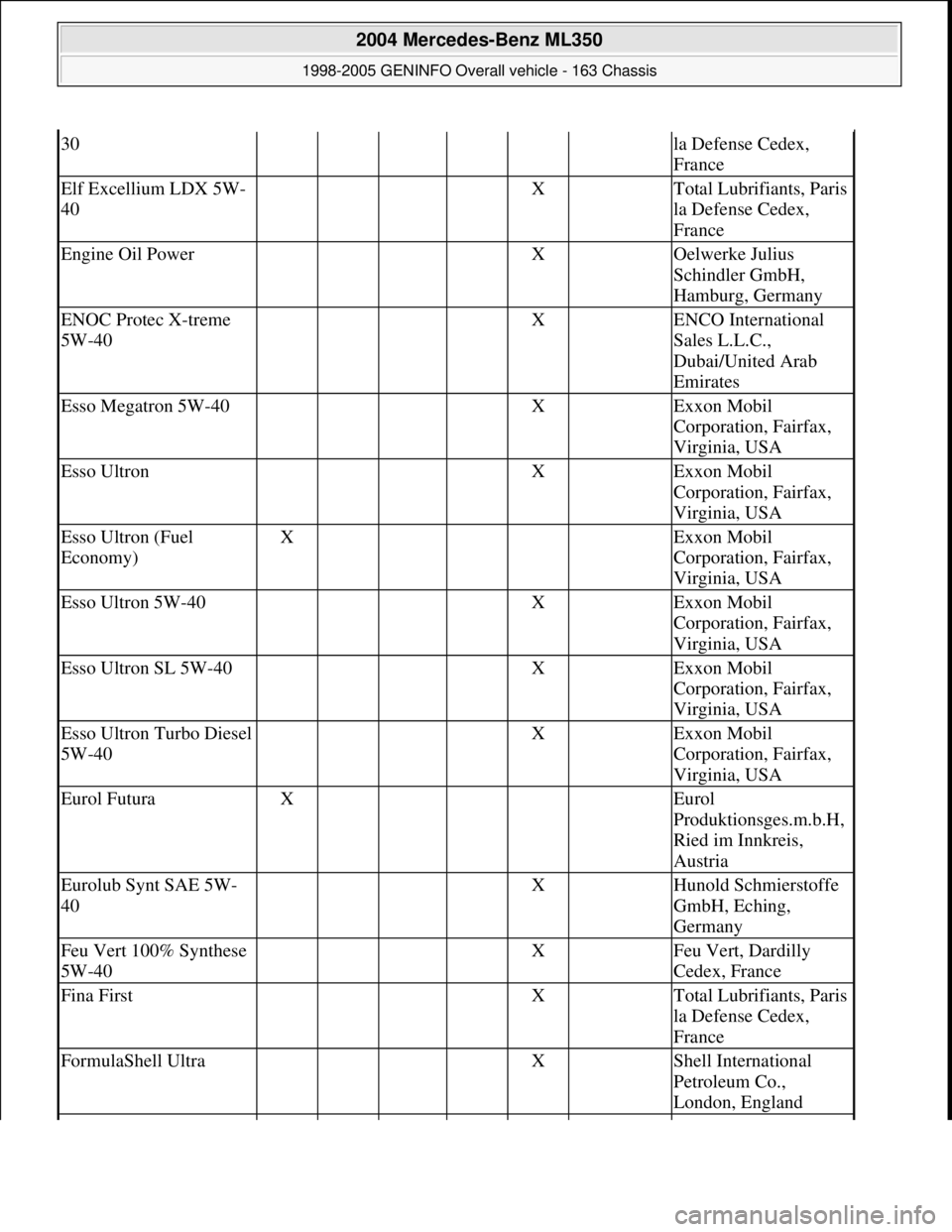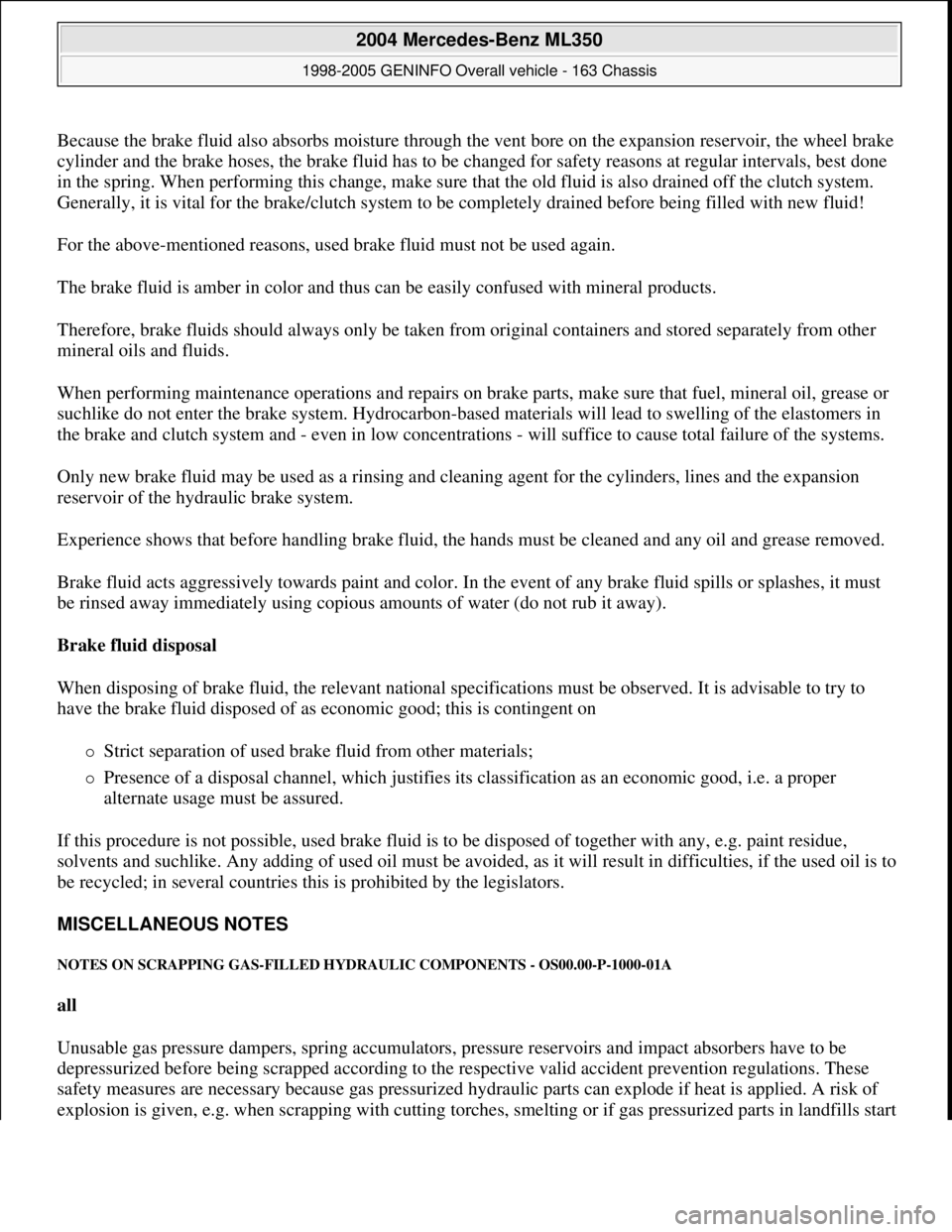1997 MERCEDES-BENZ ML430 fuel
[x] Cancel search: fuelPage 3050 of 4133

SAFETY PRECAUTIONS FOR NEW VEHICLES THAT ARE BEING PUT IN STORAGE - AP00.70-P-1000ZZ
MODELS all
and rear axle
Frame
New vehicles in the
context of this description
are vehicles for which no
inspection has been carried
out to date. For other
vehicles, the instructions
in the Specifications for
Service Products apply
In areas in which
extremely high corrosive
attacks can be expected
from experience, the
measures given here are
not always sufficient even
for new vehiclesExport countries
In these cases, proceed in
accordance with
Specifications for Service
products.
Treatment of battery if
vehicle taken out of
service AR54.10-P-0006EA
Treatment of tire inflation
pressure if vehicle taken
out of serviceFor vehicles which will be
stored for longer than 2
months, the tire inflation
pressure should be
increased to approx. 4 bar
to prevent flattening of the
contact surface.
Treatment of break system
if vehicle taken out of
serviceWarm up service brake so
that adhering moisture at
the brake disks and the
brake pads evaporates.
This prevents the brake
pad from becoming stuck
to the brake disks.
Release parking brake.
The vehicle must be
secured by engaging a
gear/park pawl or by using
wedges.
Treatment of fuel system
if vehicle taken out of To protect the fuel tank
from corrosion, we
2004 Mercedes-Benz ML350
1998-2005 GENINFO Overall vehicle - 163 Chassis
me
Saturday, October 02, 2010 3:47:52 PMPage 405 © 2006 Mitchell Repair Information Company, LLC.
Page 3051 of 4133

RENDER NEW VEHICLES, WHICH WERE IMMOBILIZED OPERATIONAL - AP00.70-P-1001ZZ
MODEL 129, 140, 163, 168, 170, 202, 203, 208, 209, 210, 211, 215, 220, 230, 240
MODEL 461.302 /332 /342 /345
MODEL
463.200 /204 /206 /207 /208 /209 /220 /221 /224/225 /227 /228 /230 /231 /232 /233 /240 /241 /243 /244 /245 /2
4
servicerecommend that the
vehicle fuel tank is
completely filled. Then
allow gasoline engines to
run warm for 2-3 minutes.
Notes on paintwork,
decorative and detachable
components AH98.00-P-9019-01Z
if necessary, corrosion
protection after painting
(Section D) AP98.00-P-0641A
1Perform delivery
inspection
2Check battery AR54.10-P-1129-01A
3
+Vent stationary heater and
top up coolantModel 163, 168, 170, 202,
203, 208, 209, 210, 211,
215, 220, 230, 240, 461,
463
Models 129, 140 with
stationary heater, code 228ra83001291165x
4Check fluid level of
engine cooling system,
correct if necessary and
check corrosion protection
as well as antifreeze and
correct if necessaryModel 129, 140, 163, 168,
170, 202, 203, 208, 209,
210, 211, 215, 220, 230,
240
Model 463 with engine
112, 113AP20.00-P-2010GA
Models 461, 463 with
engines 102, 103, 104,
117, 602, 603, 606, 612,
628AP20.00-P-2010G
Risk of accident caused
by vehicle starting off by
itself when engine is
running. Risk of injury
caused by contusions and
burns during starting Secure vehicle to prevent
it from moving. Wear
closed and snug-fitting
work clothes. Do not grasp
hot or rotating parts.AS00.00-Z-0005-01A
2004 Mercedes-Benz ML350
1998-2005 GENINFO Overall vehicle - 163 Chassis
me
Saturday, October 02, 2010 3:47:52 PMPage 406 © 2006 Mitchell Repair Information Company, LLC.
Page 3061 of 4133

Commercial vehicle engines, Industrial engines from the commercial vehicle sector (BR 300, BR 400, BR
500, BR 900)
This table only serves as an overview!
The detailed maintenance and oil change regulations can be found in the maintenance booklet for the respective
vehicle/ major assembly.
• Enable
o Can only be used in exceptional cases or under certain operating conditions/in certain applications.
- Must not be used
1. Sheets 227.0/. 1 no longer exist! Replaced by engine oils in sheets 228.0/. 1/.2/.3/.5/51.
2. Use in combination with low-sulfur (S <50 ppm) or sulfur-free (S <10 ppm) fuel! If fuels with sulfur
contents of S> 500 ppm are being used, the oil change intervals must be reduced!
3.Restriction: Onl
y "Mobil 1 5W-50", SAE 5W-50, sheet 229.3 is approved!
MB
Specifications
for
Operating
Fluids Sheet
1.)226.9
Multi-
grade228.0/.1
Single/
Multi-
grade226.9229.3
Single/
Multi-
grade229.5
Multi-
grade228.51 '
Multi-
grade229.1
Multi-
grade229.3
Multi-
grade229.31
Multi-
grade229.5
Multi-
grade229.51
Multi-
grade
Commercial
vehicles,
buses without
particulate
filter
BR 300, 400,
500, 900; OM
457, 460 up to
and including
Euro 3-o/•o/•••-----
BR 500, 900;
OM 457, 460
Euro 4/5--o/•••-----
Gas engines•---•-----
Commercial
vehicles,
buses with
particulate
filter
BR 500, 900;
OM 457, 460--oo•-----
2004 Mercedes-Benz ML350
1998-2005 GENINFO Overall vehicle - 163 Chassis
me
Saturday, October 02, 2010 3:47:52 PMPage 416 © 2006 Mitchell Repair Information Company, LLC.
Page 3130 of 4133

30la Defense Cedex,
France
Elf Excellium LDX 5W-
40 X Total Lubrifiants, Paris
la Defense Cedex,
France
Engine Oil Power X Oelwerke Julius
Schindler GmbH,
Hamburg, Germany
ENOC Protec X-treme
5W-40 X ENCO International
Sales L.L.C.,
Dubai/United Arab
Emirates
Esso Megatron 5W-40 X Exxon Mobil
Corporation, Fairfax,
Virginia, USA
Esso Ultron X Exxon Mobil
Corporation, Fairfax,
Virginia, USA
Esso Ultron (Fuel
Economy)X Exxon Mobil
Corporation, Fairfax,
Virginia, USA
Esso Ultron 5W-40 X Exxon Mobil
Corporation, Fairfax,
Virginia, USA
Esso Ultron SL 5W-40 X Exxon Mobil
Corporation, Fairfax,
Virginia, USA
Esso Ultron Turbo Diesel
5W-40 X Exxon Mobil
Corporation, Fairfax,
Virginia, USA
Eurol FuturaX Eurol
Produktionsges.m.b.H,
Ried im Innkreis,
Austria
Eurolub Synt SAE 5W-
40 X Hunold Schmierstoffe
GmbH, Eching,
Germany
Feu Vert 100% Synthese
5W-40 X Feu Vert, Dardilly
Cedex, France
Fina First X Total Lubrifiants, Paris
la Defense Cedex,
France
FormulaShell Ultra X Shell International
Petroleum Co.,
London, England
2004 Mercedes-Benz ML350
1998-2005 GENINFO Overall vehicle - 163 Chassis
me
Saturday, October 02, 2010 3:47:55 PMPage 485 © 2006 Mitchell Repair Information Company, LLC.
Page 3148 of 4133

of repairs or for service fills.
2.6 Transmission oils, sheet 235.11
The fully synthetic gear oils are approved for all MB commercial vehicle manual transmissions installed
in MB vehicles with steel/molybdenum synchronization with and without oil coolers, in MB transfer
cases with and without oil coolers as well as in ZF manual transmissions with steel/molybdenum
synchronization.
Due to the favorable viscosity/temperature characteristics, a good cold-shifting response and, due to the
composition of the transmission oil, a good thermal/oxidative stability of the oil at high transmission oil
temperatures as well as a fuel savings potential depending on the operating conditions can be expected.
2.7 Engine oils, sheet 235.12
The engine oils must be used with a common oil system for transmissions used in tropical countries, and
for manual transmissions with a torque converter and clutch unit. These engine oils display the very high
seizure resistance required for use in transmissions. The oils need not comply with the engine oil pour
point specifications in these Specifications for Operating Fluids.
2.8 Engine oils, sheet 235.27
Commercial vehicle retarder oils: the products listed in the tables apply to commercial vehicle
transmissions: see MB Specifications for Operating Fluids 231.2. The engine oils are suitable for retarder
use. The oils need not comply with the engine Specifications for Operating Fluids 231.2. The engine oils
are suitable for retarder use. The oils need not comply with the engine oil pour point specifications in
these Specifications for Operating Fluids.
3. Automatic transmission fluids (ATF), sheet 236.1/.2/.3/.5/.6/.7/.8/.81/.9/.10/.11/.12/.13/.20
ATFs are comparatively low-viscosity gear oils which, due to their universal use potential as a gear oil or
a hydraulic fluid, can cover a wide spectrum of applications. The ATFs in the individual their universal
use potential as a gear oil or a hydraulic fluid, can cover a wide spectrum of applications. The ATFs in the
individual sheets differ essentially due to their inherent friction coefficients in tribological contact. This
property predestines these oils as function fluids for automatic transmissions whose ease of shifting,
among other things, is considerably affected by the friction coefficient of the ATF. Therefore, to achieve
optimum performance of the vehicles, only the ATF quality (sheet no.) assigned to the major assembly is
to be used. The individual ATF qualities will be described in greater detail below.
3.1 Automatic transmission fluids (ATF), sheet 236.1
The approved ATF correspond to the currently no longer valid GM specification Dexron II-D or the
currently valid GM specification Dexron III.
The field of application of these ATF includes MB automatic transmissions without controlled torque
converter lockup clutch in passenger cars, ZF Ecomat transmissions, Allison automatic transmissions,
Voith-Diwa transmissions and MB automatic transmissions in commercial vehicles and busses except
2004 Mercedes-Benz ML350
1998-2005 GENINFO Overall vehicle - 163 Chassis
me
Saturday, October 02, 2010 3:47:56 PMPage 503 © 2006 Mitchell Repair Information Company, LLC.
Page 3176 of 4133

Because the brake fluid also absorbs moisture through the vent bore on the expansion reservoir, the wheel brake
cylinder and the brake hoses, the brake fluid has to be changed for safety reasons at regular intervals, best done
in the spring. When performing this change, make sure that the old fluid is also drained off the clutch system.
Generally, it is vital for the brake/clutch system to be completely drained before being filled with new fluid!
For the above-mentioned reasons, used brake fluid must not be used again.
The brake fluid is amber in color and thus can be easily confused with mineral products.
Therefore, brake fluids should always only be taken from original containers and stored separately from other
mineral oils and fluids.
When performing maintenance operations and repairs on brake parts, make sure that fuel, mineral oil, grease or
suchlike do not enter the brake system. Hydrocarbon-based materials will lead to swelling of the elastomers in
the brake and clutch system and - even in low concentrations - will suffice to cause total failure of the systems.
Only new brake fluid may be used as a rinsing and cleaning agent for the cylinders, lines and the expansion
reservoir of the hydraulic brake system.
Experience shows that before handling brake fluid, the hands must be cleaned and any oil and grease removed.
Brake fluid acts aggressively towards paint and color. In the event of any brake fluid spills or splashes, it must
be rinsed away immediately using copious amounts of water (do not rub it away).
Brake fluid disposal
When disposing of brake fluid, the relevant national specifications must be observed. It is advisable to try to
have the brake fluid disposed of as economic good; this is contingent on
Strict separation of used brake fluid from other materials;
Presence of a disposal channel, which justifies its classification as an economic good, i.e. a proper
alternate usage must be assured.
If this procedure is not possible, used brake fluid is to be disposed of together with any, e.g. paint residue,
solvents and suchlike. Any adding of used oil must be avoided, as it will result in difficulties, if the used oil is to
be recycled; in several countries this is prohibited by the legislators.
MISCELLANEOUS NOTES
NOTES ON SCRAPPING GAS-FILLED HYDRAULIC COMPONENTS - OS00.00-P-1000-01A
all
Unusable gas pressure dampers, spring accumulators, pressure reservoirs and impact absorbers have to be
depressurized before being scrapped according to the respective valid accident prevention regulations. These
safety measures are necessary because gas pressurized hydraulic parts can explode if heat is applied. A risk of
explosion is
given, e.g. when scrapping with cutting torches, smelting or if gas pressurized parts in landfills start
2004 Mercedes-Benz ML350
1998-2005 GENINFO Overall vehicle - 163 Chassis
me
Saturday, October 02, 2010 3:47:57 PMPage 531 © 2006 Mitchell Repair Information Company, LLC.
Page 3185 of 4133

AD54.30-P-2000-02GC
Notes on HHT previous knowledge diagnosis
IC
HHT :
The instrument cluster and active service system (ASSYST) sub-
function are checked with HHT, there being the choice of the
following functions for this:
1. Control module version
2. Fault memory
3. Actual values
4. Actuations
5. Control module adaptation
Additional information on test items 2, 3 and 5 can be called up using
the INPUT key
Control module adaptation
The following alternatives are available in the HHT under control
module adaptation:
1.)
Read out coding and transfer to new instrument cluster. IC and
ASSYST.
2.)
Read out/change codings e.g.:
Engine and national variants,
version of fuel tank,
special equipment etc.
3.)
Settings:
1
Clock
2
Put forward kilometer reading
3
Put back kilometer reading
4
Oil change
5
Reset oil change initiated inadvertently
6
Active Service System
7
Enter times with battery disconnected
8
Set minimum oil warning
Before replacing a defective instrument cluster, readout the existing
variant codings (driving data and instrument cluster data) and store in
the HHT on an interim basis. Read in the values stored on an interim
basis again after installing the new instrument cluster.
If it is not possible to read out the stored variant coding, all variant
codings must be input manually (menu-assistance in HHT).
When installing an instrument cluster on an experimental basis, do
not put forward the kilometer reading as it cannot be put back later.
Copyright DaimlerChrysler AG 05.06.2006 CD-Ausgabe G/10/04 . This WIS print-out will not be recorde
d by Modification services.
Page 1
Page 3186 of 4133

AP82.10-P-8260GH
Check and correct headlamp adjustment
2.7.97
MODEL
163
a=Marking for low beams
b=Marking for high beams
c=Marking for fog lamps
P82.10-0212-02
Check
1
Drive vehicle to level surface
The vehicle level must not change when the
brakes are applied.
Vehicle must be in ready-for-the-road
condition (unladen weight, fuel tank full or
proper additional weight).
Correctly adjust tire pressure.
Load driver's seat with 75 kg or a person
(except USA)
2
Align headlamp adjustment tester to vehicle
and adjust height according to marking in lens
Follow the operating instructions for
headlamp beam setting equipment exactly
*WH58.30-Z-1002-09A
Danger!
Risk of accident
from vehicle starting off by
itself when engine running.
Risk of injury
suffered in the form of bruises or burns to the
hands when reaching in while the engine
cranks or runs
Secure vehicle to prevent it from moving off
by itself.
Wear closed and close-fitting work clothes.
Do not touch hot or rotating parts.
AS00.00-Z-0005-01A
3
Run engine and switch on low beam
4
Check headlamp range control for proper
function
(except USA)
The light beams from both headlamps should
change uniformly
5
Set headlamp range control switch to position 0
6
Check low beams
Adjust if necessary (except USA)
AP82.10-P-8260-01A
Due to the common reflector unit, the low
beams, high beams and fog lamps are
adjusted simultaneously.
US version:
#
See "Owner's Manual"
7
Check high beam adjustment
AP82.10-P-8260-02A
8
Check fog lamps
AP82.10-P-8260-04A
Commercially available tools
(see Workshop Equipment Manual)
Number
Designation
Make (e.g.)
Order number
Copyright DaimlerChrysler AG 20.05.2006 CD-Ausgabe G/10/04 . This WIS print-out will not be recorde
d by Modification services.
Page 1